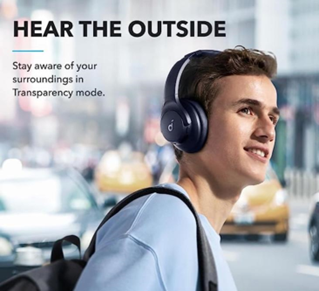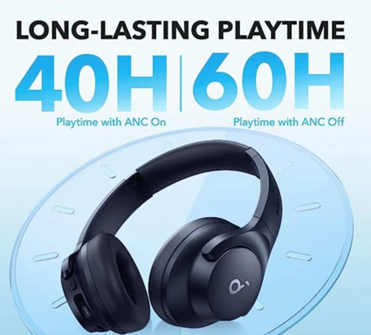Noise cancelling headphones have become a prominent feature in today’s audio landscape, transforming how we experience sound. With increasing noise pollution in urban environments and the growing need for personal audio spaces, these headphones are no longer just luxury items; they have become essential tools for many consumers. The Soundcore Q20i as best over ear noise cancelling headphones exemplify this evolution, showcasing advanced technology that enhances listening experiences. As more people seek to escape distractions, understanding the critical factors before investing in noise cancelling headphones is vital. This article will delve into the technologies behind noise cancellation, acoustic performance, comfort considerations, battery life, and overall value, ensuring you make an informed decision when purchasing your next pair.

Noise Cancelling Technologies: Understanding the Core Differences
Active Noise Cancelling (ANC): How It Works and Its Benefits
Active Noise Cancelling (ANC) technology is at the forefront of modern headphone design. It utilizes microphones to pick up ambient sounds and then generates sound waves that are the exact opposite (anti-phase) to cancel out the noise. This technology is particularly effective in environments with consistent, low-frequency sounds, such as the hum of an airplane engine or the chatter of a busy café. The Q20i employs hybrid ANC, which combines feedforward and feedback mechanisms for enhanced performance. The benefit of ANC is clear: it allows users to immerse themselves in their audio without distractions, making it ideal for travelers, commuters, and professionals alike.
Passive Noise Cancelling: The Fundamentals and When It’s Effective
In contrast to ANC, passive noise cancelling relies on the physical design of the headphones to block out external sounds. This is achieved through the use of padded ear cups that create a seal around the ears, reducing the amount of noise that enters. While passive noise cancelling is less effective against low-frequency sounds compared to ANC, it can still significantly reduce higher-frequency noises, such as voices or sharp sounds. For users who prefer a lightweight option, passive noise cancelling headphones can be an effective choice, especially in quieter environments. Understanding the differences between these technologies will help you select the right headphones for your needs.
Evaluating Acoustic Performance: How Noise Cancelling Affects Sound Quality
The Impact of ANC on Sound Clarity and Frequency Response
One of the primary concerns with noise cancelling headphones is how ANC affects sound quality. High-quality ANC systems, like that of the Q20i, are designed to minimize distortion while cancelling noise. However, some lower-end models may compromise sound clarity when ANC is activated. It’s essential to evaluate how the headphones perform across different frequencies. A well-balanced frequency response ensures that vocals are clear and bass is rich, even with ANC engaged. Before purchasing, consider testing the headphones to assess their acoustic performance and ensure they meet your audio expectations.
Balancing Noise Cancelling and High-Fidelity Audio: What to Expect
Many users desire both effective noise cancelling and high-fidelity audio. The Q20i manages this balance well, offering a rich sound profile without sacrificing ANC capabilities. However, it’s important to note that not all noise cancelling headphones achieve this equilibrium. Some models may prioritize noise cancellation at the expense of sound quality. When shopping, look for reviews and specifications that highlight the headphones' audio performance in both ANC and non-ANC modes, ensuring you find a model that delivers the best of both worlds.

Ergonomics and Design: Ensuring Comfort for Extended Use
The Importance of Fit: Over-Ear vs. In-Ear Noise Cancelling Headphones
Comfort is a crucial factor when selecting noise cancelling headphones, especially for extended use. Over-ear headphones, like the Q20i, provide a comfortable fit by enveloping the ears, which can enhance passive noise isolation. They are often preferred for long listening sessions due to their cushioning and support. In-ear models, while portable and lightweight, may not provide the same level of comfort for prolonged use. It’s essential to consider how you plan to use the headphones and choose a design that suits your preferences and lifestyle.
Material and Build Quality: Key Considerations for Long-Term Wear
The materials and build quality of headphones significantly impact their durability and comfort. The Q20i features high-quality materials that not only enhance comfort but also ensure longevity. Look for headphones with durable construction and comfortable padding, as these factors contribute to a better overall experience. Investing in well-built headphones can save you money in the long run, as they are less likely to require replacement due to wear and tear.
Battery Performance and Power Management: Maximizing Usage Time
Understanding Battery Life in Different Use Cases: ANC On vs. Off
Battery performance is another essential consideration when investing in noise cancelling headphones. The Q20i boasts an impressive battery life of up to 30 hours with ANC activated, making it ideal for long journeys or extended use. However, it’s important to note that battery life can vary significantly depending on whether ANC is turned on or off. Users should consider their typical usage scenarios and choose headphones that offer sufficient battery life for their needs.
Charging Speed and Efficiency: Features to Look For
In addition to battery life, charging speed is a crucial feature to consider. The Q20i offers fast charging capabilities, providing hours of playback from just a short charging session. This feature is particularly beneficial for users who may forget to charge their headphones overnight or need a quick boost before heading out. When evaluating headphones, look for models that offer efficient charging options to ensure you can maximize your usage time.
Cost-Benefit Analysis: Determining the Value of Your Investment
Analyzing Price Tiers: Budget, Mid-Range, and Premium Models
Noise cancelling headphones come in various price tiers, from budget options to premium models like the Q20i. While budget models may offer basic noise cancelling features, they often lack the sound quality and durability found in higher-end options. Mid-range models typically provide a good balance of performance and price, while premium models offer advanced features and superior sound quality. It’s essential to analyze your budget and determine which tier aligns with your needs and expectations.
Long-Term Value: Durability, Warranty, and Post-Purchase Support
Investing in noise cancelling headphones should also include considerations of long-term value. Look for models that offer warranties and robust customer support, as these factors can enhance your overall experience. The Q20i, for instance, is built to last and comes with a warranty that provides peace of mind. Assessing the durability and support options available can help ensure that your investment remains worthwhile over time.
Conclusion
In conclusion, investing in noise cancelling headphones requires careful consideration of various factors, including technology types, acoustic performance, comfort, battery life, and overall value. The Q20i serves as an excellent example of how advanced features can enhance the listening experience while providing effective noise cancellation. By understanding these key insights, you can make an informed purchase decision that aligns with your personal needs and preferences, ensuring you select the perfect pair of noise cancelling headphones to elevate your audio experience.